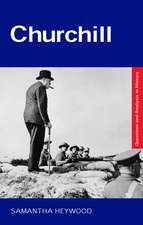British Battle Planning in 1916 and the Battle of Fromelles: A Case Study of an Evolving Skill: Routledge Studies in First World War History
Autor Roger Leeen Limba Engleză Hardback – 16 iun 2015
| Toate formatele și edițiile | Preț | Express |
|---|---|---|
| Paperback (1) | 255.40 lei 6-8 săpt. | |
| Taylor & Francis – 30 iun 2020 | 255.40 lei 6-8 săpt. | |
| Hardback (1) | 1005.80 lei 6-8 săpt. | |
| Taylor & Francis – 16 iun 2015 | 1005.80 lei 6-8 săpt. |
Din seria Routledge Studies in First World War History
-
 Preț: 316.13 lei
Preț: 316.13 lei -
 Preț: 310.36 lei
Preț: 310.36 lei -
 Preț: 330.33 lei
Preț: 330.33 lei - 18%
 Preț: 836.89 lei
Preț: 836.89 lei -
 Preț: 489.26 lei
Preț: 489.26 lei - 21%
 Preț: 255.40 lei
Preț: 255.40 lei -
 Preț: 390.63 lei
Preț: 390.63 lei -
 Preț: 469.34 lei
Preț: 469.34 lei - 17%
 Preț: 259.98 lei
Preț: 259.98 lei - 18%
 Preț: 995.58 lei
Preț: 995.58 lei -
 Preț: 384.70 lei
Preț: 384.70 lei -
 Preț: 491.17 lei
Preț: 491.17 lei -
 Preț: 416.63 lei
Preț: 416.63 lei - 18%
 Preț: 1056.80 lei
Preț: 1056.80 lei - 18%
 Preț: 998.71 lei
Preț: 998.71 lei -
 Preț: 469.34 lei
Preț: 469.34 lei -
 Preț: 386.39 lei
Preț: 386.39 lei -
 Preț: 469.34 lei
Preț: 469.34 lei - 15%
 Preț: 305.52 lei
Preț: 305.52 lei -
 Preț: 469.34 lei
Preț: 469.34 lei - 12%
 Preț: 299.52 lei
Preț: 299.52 lei -
 Preț: 384.86 lei
Preț: 384.86 lei - 25%
 Preț: 824.80 lei
Preț: 824.80 lei - 18%
 Preț: 1059.93 lei
Preț: 1059.93 lei - 18%
 Preț: 1000.27 lei
Preț: 1000.27 lei -
 Preț: 489.26 lei
Preț: 489.26 lei - 18%
 Preț: 1110.47 lei
Preț: 1110.47 lei -
 Preț: 489.26 lei
Preț: 489.26 lei - 18%
 Preț: 1000.27 lei
Preț: 1000.27 lei - 21%
 Preț: 256.32 lei
Preț: 256.32 lei - 16%
 Preț: 216.07 lei
Preț: 216.07 lei - 26%
 Preț: 820.32 lei
Preț: 820.32 lei
Preț: 1005.80 lei
Preț vechi: 1226.58 lei
-18% Nou
Puncte Express: 1509
Preț estimativ în valută:
192.45€ • 201.48$ • 159.25£
192.45€ • 201.48$ • 159.25£
Carte tipărită la comandă
Livrare economică 05-19 aprilie
Preluare comenzi: 021 569.72.76
Specificații
ISBN-13: 9781472449955
ISBN-10: 1472449959
Pagini: 244
Ilustrații: Includes 6 b&w illustrations and 12 maps
Dimensiuni: 156 x 234 x 16 mm
Greutate: 0.61 kg
Ediția:New ed.
Editura: Taylor & Francis
Colecția Routledge
Seria Routledge Studies in First World War History
Locul publicării:Oxford, United Kingdom
ISBN-10: 1472449959
Pagini: 244
Ilustrații: Includes 6 b&w illustrations and 12 maps
Dimensiuni: 156 x 234 x 16 mm
Greutate: 0.61 kg
Ediția:New ed.
Editura: Taylor & Francis
Colecția Routledge
Seria Routledge Studies in First World War History
Locul publicării:Oxford, United Kingdom
Cuprins
British Battle Planning in 1916 and the Battle of Fromelles
Notă biografică
Roger Lee is the Australian Army Historian and Head of the Australian Army History Unit. He is responsible for advising the Chief of Army on all matters relating to the Army’s history and heritage. He holds a PhD and a Master of Defence Studies from the University of New South Wales (at the Australian Defence Force Academy), a Litt.B from the Australian National University and a BA (Hons.) from the University of Queensland. The Great War is his specialization, and command and control his particular interest. This is his second book, and he has also published several articles and papers, mainly in Army-related journals. He spends his leave conducting battlefield tours of both Gallipoli and the Western Front.
Descriere
The Battle of Fromelles (19-20 July 1916) witnessed the first time Australian forces were used in offenses on the Western Front, and thus looms large in Commonwealth perceptions of ’Bumbling British Generals’. This book follows the battle plan from the supreme commander’s strategic designs down through the commands at operational and tactical headquarters until it became the orders sending the infantry into the attack. In so doing it provides a unique insight into the strengths and weaknesses of British command structure, allowing a more scholarly judgement of its effectiveness.
















